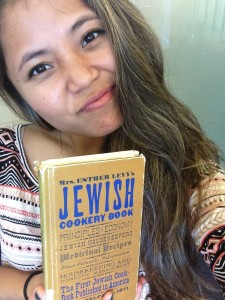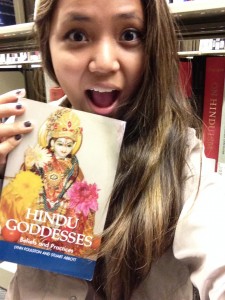Jewish cookery book, on principles of economy: adapted for Jewish housekeepers, with the addition of many useful medicinal recipes, and other valuable information, relative to housekeeping and domestic management, Esther Levy – Applewood Books- 2007
I became interested in religions and food after reading and discussing about Jewish laws of food in class. So for this shelfie, I searched “Judaism and food” in the Lafayette Library Catalog. The one book that came up on my search was called “Death Warmed Over: Funeral food, Rituals, and Customs From Around the World” by Lisa Rogak. Without even reading the entire title of the book, I decided to go check it out. When I saw that it was a book on funeral related foods, I decided that I needed to find another book. The area that I was in had only cookbooks. But in the middle of that shelf section, there were about 10 books on Jewish foods and cookbooks. I picked up the smallest one out of them and was glad to find that it was not a cookbook with recipes but a book that covered Jewish food rituals and customs.
The title of this book, written by Mrs. Esther Levy, is called “Jewish Cookery Book on Principles of Economy adapted for Jewish Housekeepers with Medicinal Recipes and Other Valuable Information Relative to Housekeeping and Domestic Management and Being The First Jewish Cookbook Published in America as Published in Philadelphia, 1871.” What I liked about this book was that the title pretty much gave away the entire content of the book. I don’t think I have ever read an actual book with such a long title. The book is small in size and is 200 pages. The cover is also old fashioned with about ten different fonts and styles.
After the preface, the introduction of the book gives “some information as to the manner of strictly keeping a Jewish house.” The book then goes on to talk about the Arrangement of The Table for breakfast, luncheon, and dinner. It also gives instruction on How to Place Dishes on the Table. The rest of the book is divided into different types of food (fish, soups, meat, poultry, bread, cakes, puddings, pastry, preserves/jellies, diet for invalids/sick, medicinal, cheese/wine, pickles/vegetables, and miscellaneous) and how to prepare them and place them. The last pages of the book give advise and tip to housekeepers, Seasonable Food for Each Month of the Year, and Culinary Utensils and Articles, which should be in All Kitchens.
If I decide to write my paper on Jewish dietary laws, this book would be very helpful. It contains so much information on every topic related to Jewish dietary laws while also keeping it in simple language. Since this is an older book, it would also be pretty reliable.

